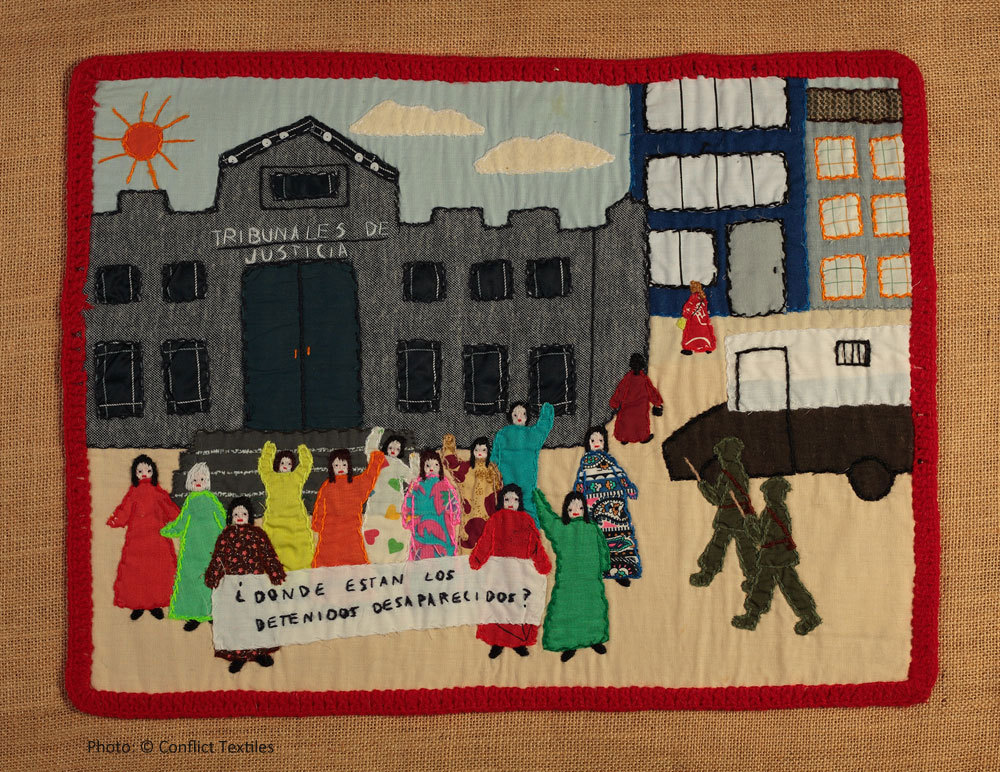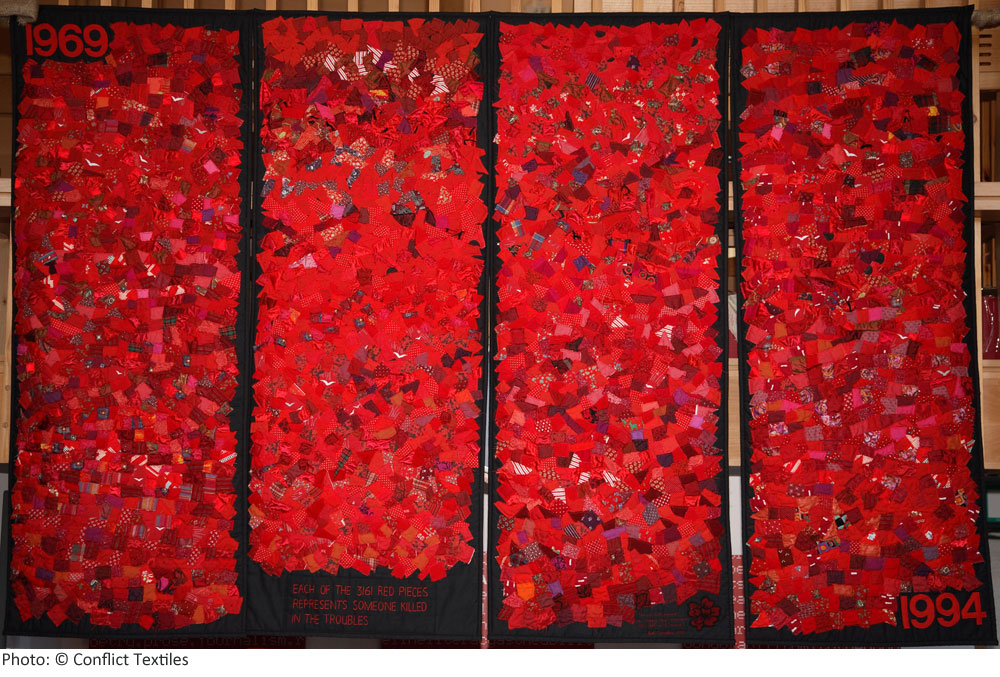
CAIN Associate Programme
Conflict Textiles and CAIN: Learning the Language of Textiles This paper provides a summary of the information presented in the webinar on 6th October 2021 – Conflict Textiles and CAIN: Learning the Language of Textiles. This paper should be read in conjunction with the Webinar recording and the Conflict Textiles presentation slides. CAIN (the Conflict Archive on the Internet) What is Conflict Textiles? Conflict Textiles is a unique cultural heritage collection that has its origins back in 2008 when Roberta Bacic (its curator) planned and organized an exhibition in Derry/Londonderry. At that time Professor Brandon Hamber, Ulster University (UU), suggested that the exhibition be documented online. Roberta approached CAIN - Conflict Archive on the INternet (https://cain.ulster.ac.uk/index.html) and met with Dr Martin Melaugh, CAIN Director, in order to make arrangements to allow for the exhibition details to be catalogued on a website associated to CAIN. This was the beginning of the CAIN / Conflict Textiles collaboration. The initial online site was comprised of a few static pages. However, it was agreed at an early stage, that if possible, everything would be documented online. In the years since the physical collection has grown to the extent that in September 2022 it contained 398 international textiles, with a focus on elements of conflict and human rights abuses. Alongside this the online resource provides full details of each textile with images, and information on the 249 associated events ‑ exhibitions, tours, films, workshops and other participatory activities. To date the collection has documented pieces from at least 40 different countries. All of the activity associated to Conflict Textiles is built on a team model. The core team works with CAIN, with ARK and a myriad of groups and entities to promote the textiles and build networks. This is a very important part of the approach taken by Conflict Textiles. Each connection is relevant and gives life to the collection and opens access to new worlds – all helping promote the Textile Language of Conflict. The textiles within the collection originated with Chilean arpilleras. In essence these are three-dimensional appliquéd tapestries and are forms of expression developed by Chilean women under the Pinochet dictatorship between 1973 and1990. In creating their arpilleras the women used what they had at hand, including flour sacks or potato sacks, cutting them into pieces to 'write' their stories in the textiles. Roberta has been involved with the issue of the 'disappeared' in Chile since 1975, and this is a central theme of the collection.
¿Dónde están los desaparecidos? / Where are the "disappeared"? Roberta knew from her experiences that women in Northern Ireland would have talked about 'the troubles' because of how they impacted directly on their families, communities and country. There was a suggestion that these women had not done anything to convey their experiences in terms of textiles; yet as had been shown in Chile, textiles provide an important mechanism through which women can express themselves. Thus, for the exhibition in 2008, The Art of Survival: International and Irish Quilts, it was very important to research what textiles had been made in Northern Ireland about the 'troubles'.
Peace Quilt- Common Loss The Conflict Textiles collection primarily contains textiles that depict human rights abuses and the impact of war. It took some time to find a name for the collection. The two words 'Conflict Textiles' make it clear that the collection concentrates on political conflict, violence or war, as well as focusing on the textiles and sewing. The textiles can be broadly grouped into four thematic areas. Firstly, is the issue of the 'disappeared'. As previously noted, it is the core element of Conflict Textiles and each exhibition will have at least one piece on this subject. This is to ensure that the world is always aware that the 'disappeared' are part of the lives of everyone. The collection brings the 'disappeared' to mind and acknowledges the struggles of relatives and community groups for truth, justice and reparations, or, at the very least, demands acknowledgement of their plight. Secondly, is the issue of refugees which has been central to the collection over many years. Thirdly, for the past 10 years there has been a focus on Holocaust Day (27 January). In January 2021 Conflict Textiles engaged in an exhibition and associated programme Light during the darkness: Remembering the Holocaust with the Linen Hall Library in Belfast. Due to COVID-19 restrictions, a short film (14 minutes) was produced to reach a broad audience and showcase the selected textiles Light during the darkness: Remembering the Holocaust. Fourthly, overarching all other themes, is the wider issue of human rights. In many ways, this is the major subject of the archive, not only in terms of human rights violations but also of the need to engage in and promote a culture of respecting human rights. This approach has, for example, allowed Conflict Textiles to work on Children's Rights, where it has engaged with schools, communities and beyond to contribute to a culture of respect for Human Rights. Two examples of this are Embracing Human Rights: Conflict Textiles' Journey (2020) and #ChildrensRights / #DerechosdelNiño / #DretsdelsInfants (2021). Conflict Textiles and Ulster University As noted, the archive was established in 2008 in conjunction with the The Art of Survival: International and Irish Quilts exhibition in Derry. In 2014 CAIN led a project with INCORE (Ulster University) and ARK called Accounts of the Conflict funded by PEACE III. The aim of the project was the creation of an archive in Ulster University to hold stories or accounts, in any form, about personal experiences of the conflict. At the outset, the focus was predominately on oral testimony, articles and chapters in books. However, while working with Roberta on Textile Accounts of Conflicts (2014) the importance of recognising and archiving 'textile language' accounts became obvious. Within Accounts of the Conflict it became possible to include 10 textiles as part of that important archive and this was to prove a very important link with CAIN. In addition, during Accounts of the Conflict further work was undertaken to grow the digital repository into a fully searchable website. The creation of this online repository where the textiles and events are interlinked, cross referenced and searchable is unique, and the site is used by scholars, textile artists and others across the world to great effect. In 2017 Ulster University hosted an international colloquium Textile Language of Conflicts that brought together international practitioners and scholars concerned with the textile language of conflict. The links between Conflict Textiles and Ulster University have continued to develop. In 2020, Conflict Textiles were invited to install a permanent rotating exhibition in the Library at Ulster University's Magee Campus Conflict Textiles collection: Magee Campus Library, Ulster University. Conflict Textiles remains grateful to Dr. Melaugh, CAIN and Mike McCool (ARK ICT Director), for all their work over the years in planning and developing this unique online archive and repository. The Online Archive Partnerships and Mission For Roberta the careful documentation of textiles and events, is an ideal way to motivate and encourage partners and contributors to value what they have done and continue with their work. An example of how partnerships have developed, has been the relationship Conflict Textiles has built – relating to the issue of refugees – is that with Tom Green from Platforma Festival and Counterpoints Arts. Tom discovered Conflict Textiles via the online archive, attended an online seminar associated with the event Following the footsteps of the disappeared (2020) and then invited Conflict Textiles to be artist in residence for the Platforma6 Festival through an exhibition and film Suitcases: Telling Textile Travels /Maletas: Contando Viajes Textiles (2021). The core mission of Conflict Textiles remains the need to ensure that these important textiles are preserved, documented and exhibited, and that their messages are heard via 'textile language'. This is done to give encouragement, to spread and share the work, and to encourage others to value what it does. As noted, the textiles provide their creators, many of whom have been unable to provide their own oral testimony, with a voice and validity. A vital element of the value of the collection is in the interaction between the textiles; no piece is more valuable than another. The pieces live together both physically and in the online archive. Conflict Textiles encourages those viewing the textiles to interact with them and see what it brings out in themselves. Conflict Textiles team, September 2022 Gillian Robinson, is a Conflict Textiles Associate and Advisor. CAIN CAIN Associate Programme
|
CAIN
contains information and source material on the conflict
and politics in Northern Ireland. CAIN is based within Ulster University. |
|
|
|||
|
Last modified :
|
||
|
| ||

